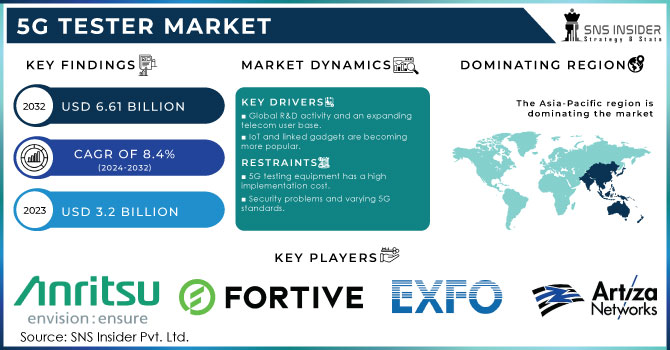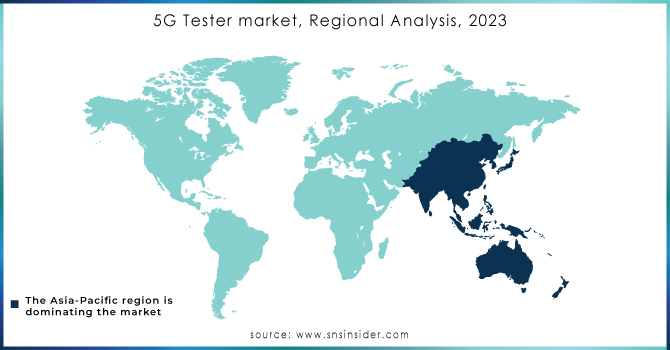5G Tester Market Report Scope & Overview:
5G Tester Market was valued at USD 3.45 billion in 2023 and is expected to reach USD 7.05 billion by 2032, growing at a CAGR of 8.29% from 2024-2032.This report includes an analysis of technology adoption rates, investment trends, spectrum allocation trends, and regulatory compliance metrics shaping the market. Increasing demand for high-speed connectivity is accelerating 5G infrastructure deployment, driving the need for advanced testing solutions. Significant investments in network optimization and spectrum efficiency are influencing market growth. Additionally, evolving regulatory frameworks are pushing vendors to develop compliant and scalable 5G testing solutions, ensuring network reliability.

Get more information on 5G Tester Market - Request Sample Report
Market Dynamics
Drivers
-
Expanding 5G Networks Drive Demand for Advanced Testing Solutions to Ensure Performance, Reliability, and Compliance in a High-Speed Era.
The intensive deployment of 5G networks across the globe is building up a high demand for advanced testing solutions to guarantee smooth connectivity, performance, and regulatory compliance. With telecom operators and businesses rolling out next-generation networks, they need accurate signal verification, latency tests, and spectrum efficiency tests to fulfill increasing expectations of high-speed, low-latency applications. Also, the convergence of IoT, AI-based automation, and intelligent infrastructure is further exacerbating the demand for trusted testing tools. With more investments being made in network densification, small cell deployments, and private 5G networks, businesses are giving high priority to end-to-end 5G testing solutions to maximize efficiency, resolve network problems, and ensure high-quality service delivery in a changing connectivity scenario.
Restraints
-
High Investment Requirements Limit Adoption of 5G Testing Solutions Among Small and Mid-Sized Enterprises
The implementation of 5G testing solutions requires highly specialized hardware, software, and frequent upgrades and hence is a very expensive endeavor for companies. Small and mid-sized businesses are especially not in a position to dedicate huge amounts of money toward sophisticated network test equipment, so their capability to ensure the maximum performance, conformance, and reliability is restrained. The high-precision requirement of tools, real-time analytics, and mmWave spectrum analysis also adds cost. As 5G infrastructure continues to grow, the cost of acquiring and maintaining testing solutions is a major hindrance, hampering mass adoption. In the absence of affordable alternatives, numerous businesses struggle to realize seamless 5G deployment, network verification, and quality assurance, which affect overall market growth.
Opportunities
-
AI-Driven Analytics and Automation Enhance 5G Testing Efficiency by Reducing Manual Effort, Improving Accuracy, and Accelerating Network Optimization.
Blending AI-driven analytics and automated test solutions is changing 5G network validation and optimization by boosting efficiency and precision. Conventional testing is labour-intensive, requiring long hours of manual intervention at increased costs and deployment times. AI-based test solutions provide instant analysis of real-time data, predictive maintenance, and fault auto-detection so that operators are able to automatically detect and clear network problems even before they create downtime. In addition, machine learning algorithms improve test accuracy by continually optimizing performance standards. With increasingly complex 5G networks, automated solutions cut human error, testing time, and operational expenses significantly, making them a vital part of guaranteeing smooth connectivity, compliance, and performance in next-generation telecom infrastructure.
Challenges
-
Advanced 5G Technologies Like mmWave, Beamforming, and Network Slicing Increase Testing Complexity, Requiring More Resources and Sophisticated Validation Methods.
The introduction of mmWave, beamforming, and network slicing into 5G networks has introduced considerable new complexity to validating networks and performing testing for performance. As a difference from its predecessors, 5G covers more frequency bands, demanding additional equipment and talent for facilitating fault-free connections. The application of beamforming technology adds complexity still, with it changing the form of signals on the fly for optimized coverage, thus creating increasingly complicated real-time testing. Moreover, network slicing, which allows for several virtual networks in one infrastructure, requires accurate verification to guarantee efficiency and security. These technologies need large resources, high-precision testing tools, and experts, making 5G testing a technically challenging and resource-consuming activity for telecom operators and service providers.
Segment Analysis
By Offering
Hardware contributed the highest share of revenue, amounting to nearly 66% in 2023, supported by high demand for specialist testing equipment including signal analyzers, spectrum analyzers, and network analyzers. The higher installations of 5G infrastructure call for cutting-edge hardware solutions to validate 5G networks in real time, test signal integrity, and test for compliance. Telecom operators and businesses are also investing big-time in high-end testing instruments for ensuring seamless connectivity of 5G.
The service segment is also expected to register the fastest CAGR of 9.62% during the forecast period from 2024 to 2032, driven by increasing adoption of managed testing services, consulting, and network optimization solutions. With growing complexity in 5G networks, organizations increasingly turn to third-party testing service providers for real-time diagnostics, predictive maintenance, and compliance checks. Cloud-based testing solutions and remote network monitoring services are also propelling market growth.
By End-User Industry
The Telecom Service Providers segment captured the largest revenue percentage of approximately 41% in 2023 with large-scale deployments of 5G networks and infrastructure upgrade. Such providers need large-scale testing of their networks, validation of performance, and compliance checks for guaranteed connectivity and service quality. Moreover, growing use cases in low-latency applications, IoT integration, and private 5G networks further accelerated investment in cutting-edge testing solutions, which further supported the leadership of this segment.
The Telecom Equipment Manufacturers segment is anticipated to expand at the fastest CAGR of 9.96% during 2024-2032, driven by ongoing innovation in 5G technology, growing R&D expenditure, and surging demand for high-performance network hardware. With telecom operators upgrading their infrastructure, manufacturers are concentrating on creating advanced 5G testing solutions to accommodate changing network architectures, such as mmWave, network slicing, and Open RAN technologies, which is driving swift market growth.
Regional Analysis
North America held the highest revenue share of about 37% in 2023, driven by early 5G adoption, significant investments in telecom infrastructure, and strong regulatory support. The presence of major telecom operators, technology providers, and network testing companies has further boosted market dominance. Additionally, the high demand for private 5G networks, IoT applications, and smart city initiatives has led to increased deployment of advanced 5G testing solutions, ensuring network reliability, security, and compliance with evolving industry standards.
Asia Pacific is expected to grow at the fastest CAGR of 9.85% from 2024 to 2032, fueled by rapid 5G network expansions, increasing government investments, and rising demand for high-speed connectivity. Countries like China, Japan, South Korea, and India are leading 5G deployments, driving the need for advanced testing equipment and services. Additionally, the region’s growing telecom subscriber base, expanding manufacturing sector, and increasing smart infrastructure projects are accelerating the demand for cost-effective and scalable 5G testing solutions.

Do you need any custom research on 5G Tester Market - Enquiry Now
Key Players
-
Anritsu (Signal Generators, Spectrum Analyzers)
-
Keysight Technologies (Network Emulation Solutions, Private Network Solutions)
-
Teradyne Inc. (mmWave Test Instruments, RF Test Systems)
-
National Instruments Corporation (Signal Generators, Oscilloscopes)
-
Spirent Communications (5G Network Testing Solutions, 5G Device Testing Solutions)
-
Viavi Solutions Inc. (5G Network Test Solutions, 5G Lab Testing Solutions)
-
Macom (RF Power Amplifiers, mmWave Products)
-
Rohde & Schwarz (Signal Generators, Spectrum Analyzers)
-
GL Communications Inc. (5G Network Test Solutions, Protocol Analyzers)
-
Exfo Inc. (5G Network Testing Solutions, 5G Lab Testing Solutions)
-
Simnovus (UE Simulator, O-RU Simulator)
-
Pctel, Inc. (Gflex Scanning Receiver, MXflex Scanning Receiver)
-
Marvin Test Solutions, Inc. (5G Device Test Systems, RF Test Systems)
-
Innowireless Co Ltd. (5G Network Test Solutions, Protocol Analyzers)
-
GI Communications, Inc. (5G Network Test Solutions, RF Test Systems)
-
Gao Tek & GAO Group, Inc (Signal Generators, Spectrum Analyzers)
-
Emite (5G OTA Test Systems, Channel Emulators)
-
Consultix Wireless (5G Network Test Solutions, RF Test Systems)
-
Cohu, Inc. (5G Device Test Systems, RF Test Systems)
-
Aritza Networks, Inc. (5G Network Test Solutions, Protocol Analyzers)
-
Anokiwave, Inc. (mmWave ICs, Beamformer ICs)
-
Accuver (5G Network Test Solutions, Protocol Analyzers)
-
Accedian (5G Network Performance Monitoring Solutions, Network Analytics Solutions)
Recent Developments:
-
In 2024, Anritsu enhanced its New Radio RF Conformance Test System ME7873NR Lite Model, enabling both RF and protocol conformance testing for 5G devices using a single one-box tester.
-
In 2024, Spirent Communications introduced new 5G Fixed Wireless Access (FWA) testing services, enabling CSPs and device manufacturers to optimize customer experience through advanced lab-based gateway testing and live network competitive benchmarking.
| Report Attributes | Details |
|---|---|
| Market Size in 2023 | USD 3.45 Billion |
| Market Size by 2032 | USD 7.05 Billion |
| CAGR | CAGR of 8.29% From 2024 to 2032 |
| Base Year | 2023 |
| Forecast Period | 2024-2032 |
| Historical Data | 2020-2022 |
| Report Scope & Coverage | Market Size, Segments Analysis, Competitive Landscape, Regional Analysis, DROC & SWOT Analysis, Forecast Outlook |
| Key Segments | • By Offering (Hardware, Service) • By End-User Industry (IDMs & ODMs, Telecom Equipment Manufacturers, Telecom Service Providers, Others) |
| Regional Analysis/Coverage | North America (US, Canada, Mexico), Europe (Eastern Europe [Poland, Romania, Hungary, Turkey, Rest of Eastern Europe] Western Europe] Germany, France, UK, Italy, Spain, Netherlands, Switzerland, Austria, Rest of Western Europe]), Asia Pacific (China, India, Japan, South Korea, Vietnam, Singapore, Australia, Rest of Asia Pacific), Middle East & Africa (Middle East [UAE, Egypt, Saudi Arabia, Qatar, Rest of Middle East], Africa [Nigeria, South Africa, Rest of Africa], Latin America (Brazil, Argentina, Colombia, Rest of Latin America) |
| Company Profiles | Anritsu, Keysight Technologies, Teradyne Inc., National Instruments Corporation, Spirent Communications, Viavi Solutions Inc., Macom, Rohde & Schwarz, GL Communications Inc., Exfo Inc., Simnovus, Pctel Inc., Marvin Test Solutions Inc., Innowireless Co Ltd., GI Communications Inc., Gao Tek & GAO Group Inc., Emite, Consultix Wireless, Cohu Inc., Aritza Networks Inc., Anokiwave Inc., Accuver, Accedian |

